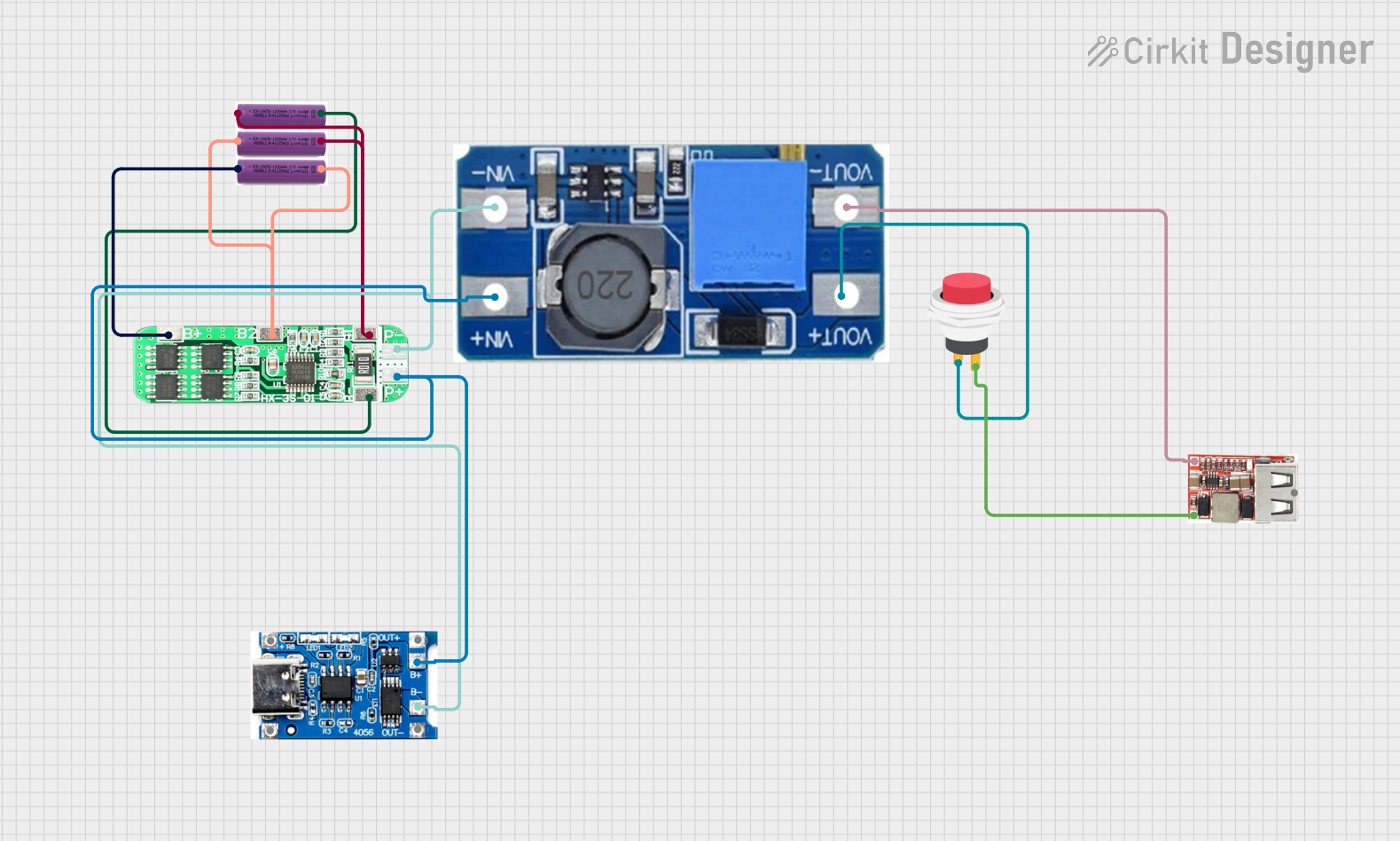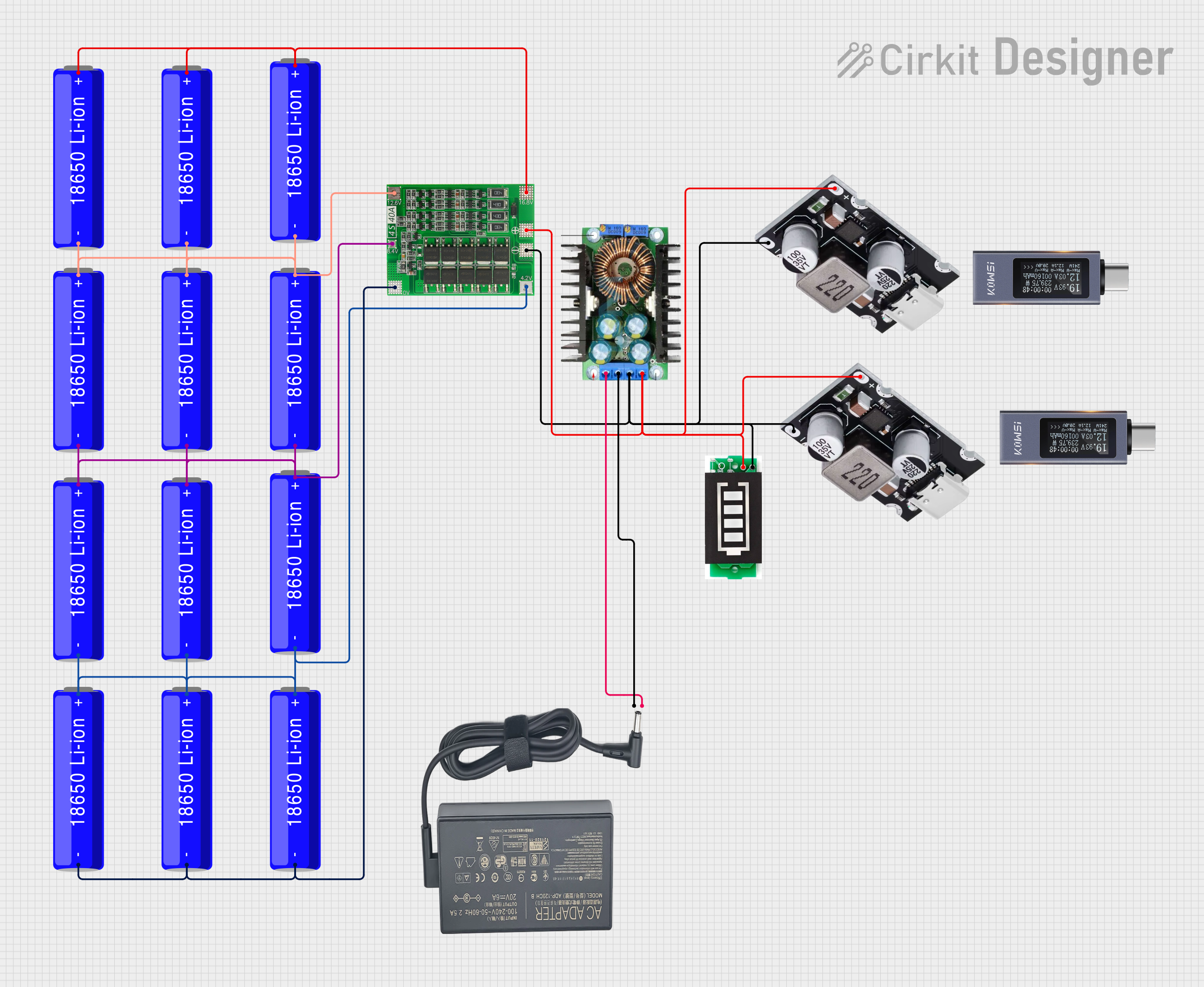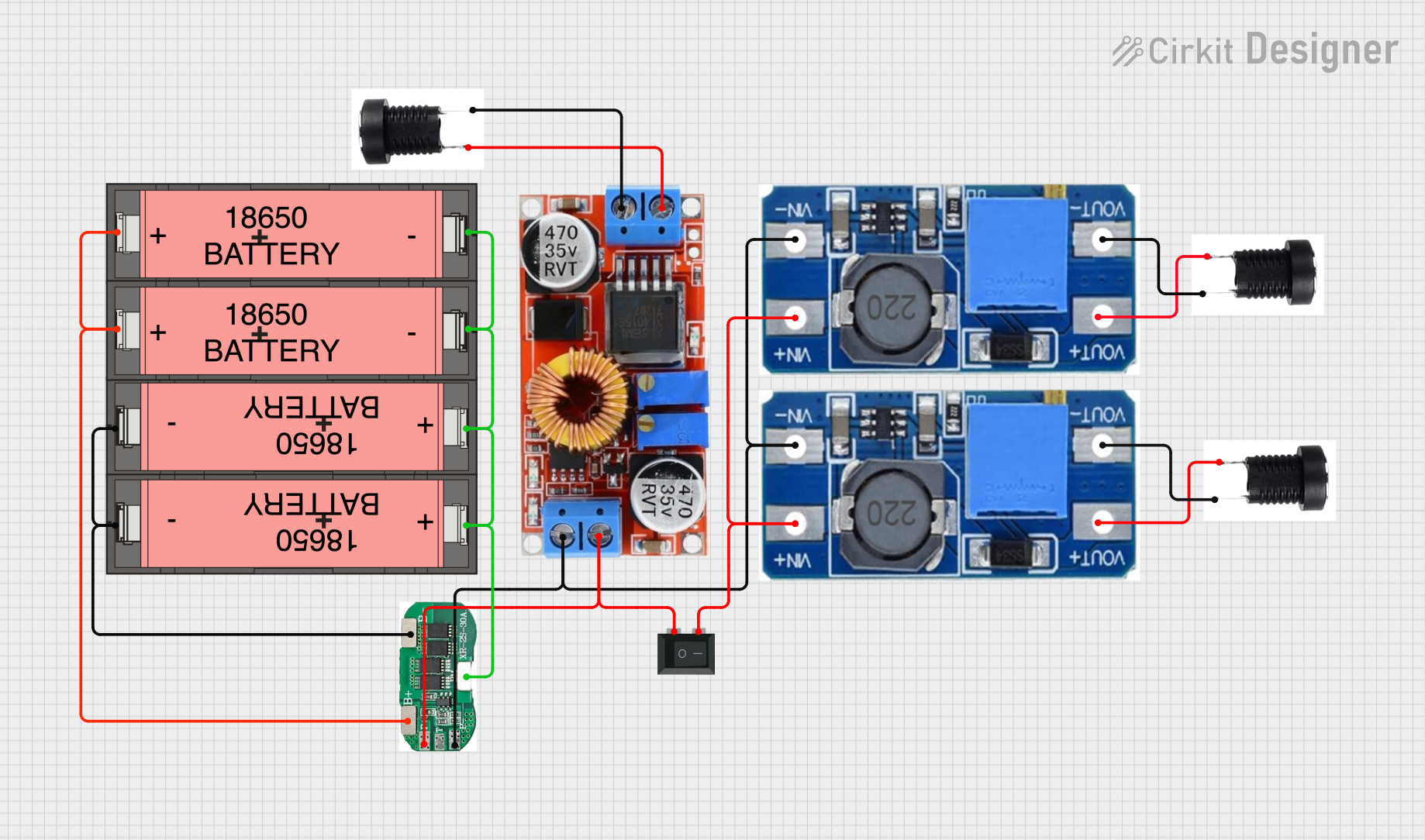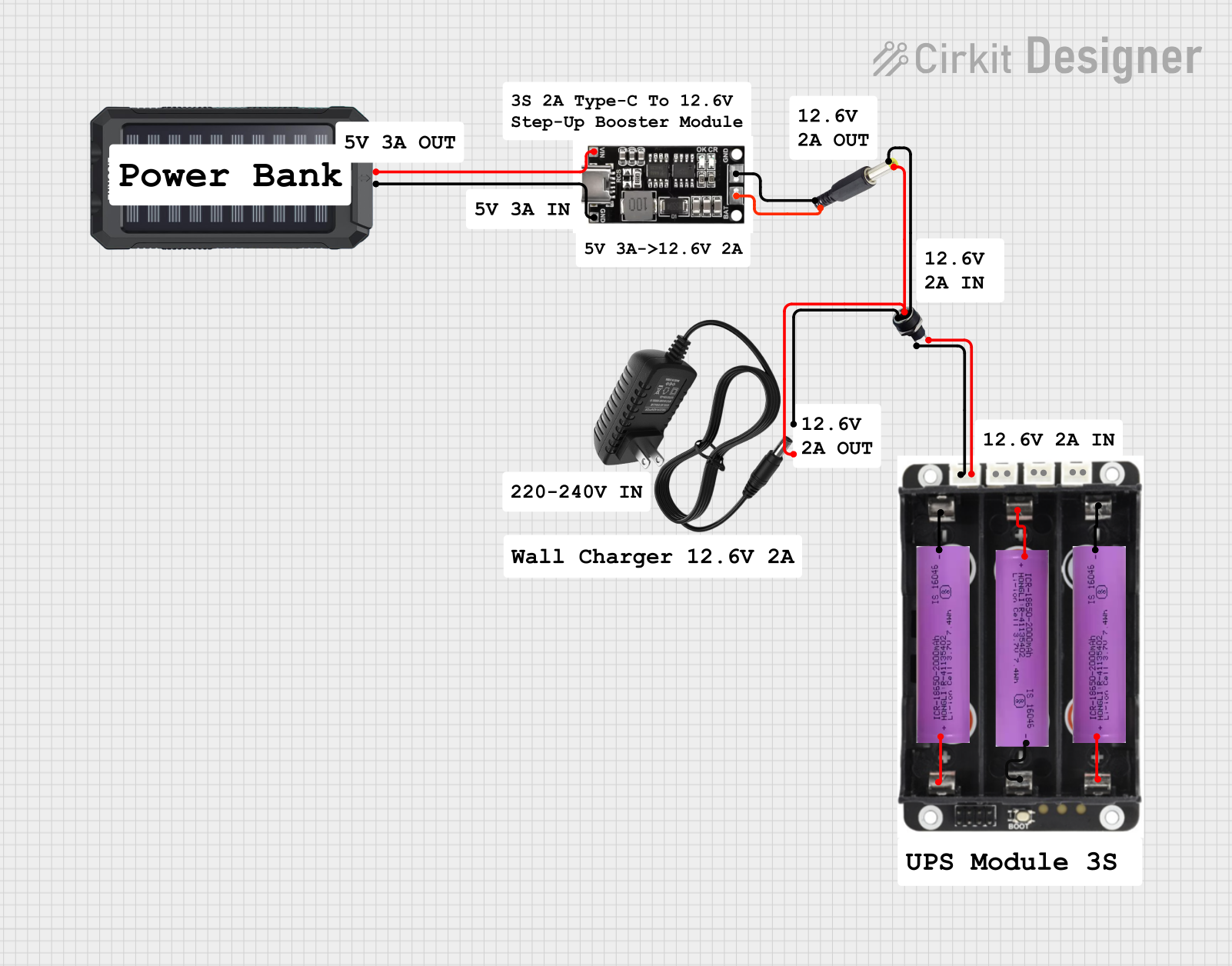
How to Use Li-ion battery 18650-2000mAh 3.7V 7.4WH: Examples, Pinouts, and Specs

 Design with Li-ion battery 18650-2000mAh 3.7V 7.4WH in Cirkit Designer
Design with Li-ion battery 18650-2000mAh 3.7V 7.4WH in Cirkit DesignerIntroduction
The Li-ion Battery 18650-2000mAh 3.7V 7.4Wh is a rechargeable lithium-ion battery with a cylindrical shape. It is rated at a 2000mAh capacity, a nominal voltage of 3.7V, and an energy storage capacity of 7.4 watt-hours. This battery is widely used in portable electronics, power tools, flashlights, and electric vehicles due to its high energy density, lightweight design, and rechargeability.
Explore Projects Built with Li-ion battery 18650-2000mAh 3.7V 7.4WH

 Open Project in Cirkit Designer
Open Project in Cirkit Designer
 Open Project in Cirkit Designer
Open Project in Cirkit Designer
 Open Project in Cirkit Designer
Open Project in Cirkit Designer
 Open Project in Cirkit Designer
Open Project in Cirkit DesignerExplore Projects Built with Li-ion battery 18650-2000mAh 3.7V 7.4WH

 Open Project in Cirkit Designer
Open Project in Cirkit Designer
 Open Project in Cirkit Designer
Open Project in Cirkit Designer
 Open Project in Cirkit Designer
Open Project in Cirkit Designer
 Open Project in Cirkit Designer
Open Project in Cirkit DesignerCommon Applications
- Powering portable electronic devices such as flashlights, cameras, and handheld tools.
- Battery packs for laptops, drones, and electric vehicles.
- Energy storage in solar-powered systems and backup power supplies.
- DIY electronics projects and robotics.
Technical Specifications
Below are the key technical details and pin configuration for the Li-ion Battery 18650-2000mAh 3.7V 7.4Wh:
Key Technical Details
| Parameter | Specification |
|---|---|
| Battery Type | Lithium-ion (Li-ion) |
| Model | 18650 |
| Nominal Voltage | 3.7V |
| Capacity | 2000mAh |
| Energy Storage | 7.4Wh |
| Maximum Charging Voltage | 4.2V |
| Discharge Cut-off Voltage | 2.5V |
| Maximum Discharge Current | 2C (4A for 2000mAh capacity) |
| Charging Current | Standard: 0.5C (1A), Max: 1C (2A) |
| Dimensions | 18mm (diameter) x 65mm (length) |
| Weight | ~45g |
| Operating Temperature | Charge: 0°C to 45°C, Discharge: -20°C to 60°C |
Pin Configuration
The 18650 battery has two terminals:
| Pin Name | Description |
|---|---|
| Positive (+) | Positive terminal for power output |
| Negative (-) | Negative terminal for power return |
Note: Ensure proper polarity when connecting the battery to avoid damage to the battery or circuit.
Usage Instructions
How to Use the Component in a Circuit
- Connection: Connect the positive terminal (+) of the battery to the positive input of your circuit and the negative terminal (-) to the ground (GND).
- Charging: Use a dedicated Li-ion battery charger with a constant current/constant voltage (CC/CV) charging profile. Ensure the charger supports a maximum charging voltage of 4.2V and a charging current of up to 1C (2A for this battery).
- Protection Circuit: Always use a Battery Management System (BMS) or a protection circuit module (PCM) to prevent overcharging, over-discharging, and short circuits.
- Series/Parallel Configuration: For higher voltage or capacity, connect multiple batteries in series or parallel. Use a BMS designed for the specific configuration.
Important Considerations and Best Practices
- Polarity: Double-check the polarity before connecting the battery to a circuit.
- Charging Safety: Never charge the battery without a proper charger or BMS.
- Storage: Store the battery in a cool, dry place at a charge level of 40-60% for long-term storage.
- Avoid Overheating: Do not expose the battery to temperatures above 60°C or direct sunlight.
- Disposal: Dispose of the battery responsibly at a certified recycling facility.
Example: Using the Battery with an Arduino UNO
To power an Arduino UNO with the 18650 battery, you can use a DC-DC step-up converter to boost the 3.7V to 5V. Below is an example circuit and code:
Circuit Setup
- Connect the battery's positive terminal to the input of the DC-DC step-up converter.
- Connect the converter's output to the Arduino UNO's 5V and GND pins.
- Ensure the step-up converter is configured to output 5V.
Arduino Code Example
// Example code to blink an LED using Arduino UNO powered by 18650 battery
// Ensure the DC-DC converter outputs 5V to the Arduino UNO
const int ledPin = 13; // Built-in LED pin on Arduino UNO
void setup() {
pinMode(ledPin, OUTPUT); // Set LED pin as output
}
void loop() {
digitalWrite(ledPin, HIGH); // Turn the LED on
delay(1000); // Wait for 1 second
digitalWrite(ledPin, LOW); // Turn the LED off
delay(1000); // Wait for 1 second
}
Troubleshooting and FAQs
Common Issues and Solutions
Battery Not Charging:
- Cause: Faulty charger or incorrect charging voltage.
- Solution: Verify the charger outputs 4.2V and is compatible with Li-ion batteries.
Battery Drains Quickly:
- Cause: Over-discharge or aging battery.
- Solution: Avoid discharging below 2.5V and replace the battery if it has degraded.
Battery Overheats During Use:
- Cause: Excessive current draw or short circuit.
- Solution: Use a BMS and ensure the load does not exceed the maximum discharge current.
No Output Voltage:
- Cause: Protection circuit triggered due to over-discharge or short circuit.
- Solution: Recharge the battery to reset the protection circuit.
FAQs
Q: Can I use this battery without a protection circuit?
A: It is not recommended. A protection circuit ensures safe operation and prevents damage.Q: How many charge cycles can this battery handle?
A: Typically, the battery can handle 300-500 charge cycles under proper usage conditions.Q: Can I connect multiple 18650 batteries in series?
A: Yes, but ensure you use a BMS designed for the series configuration to balance the cells.Q: What happens if I overcharge the battery?
A: Overcharging can cause overheating, swelling, or even explosion. Always use a proper charger with overcharge protection.